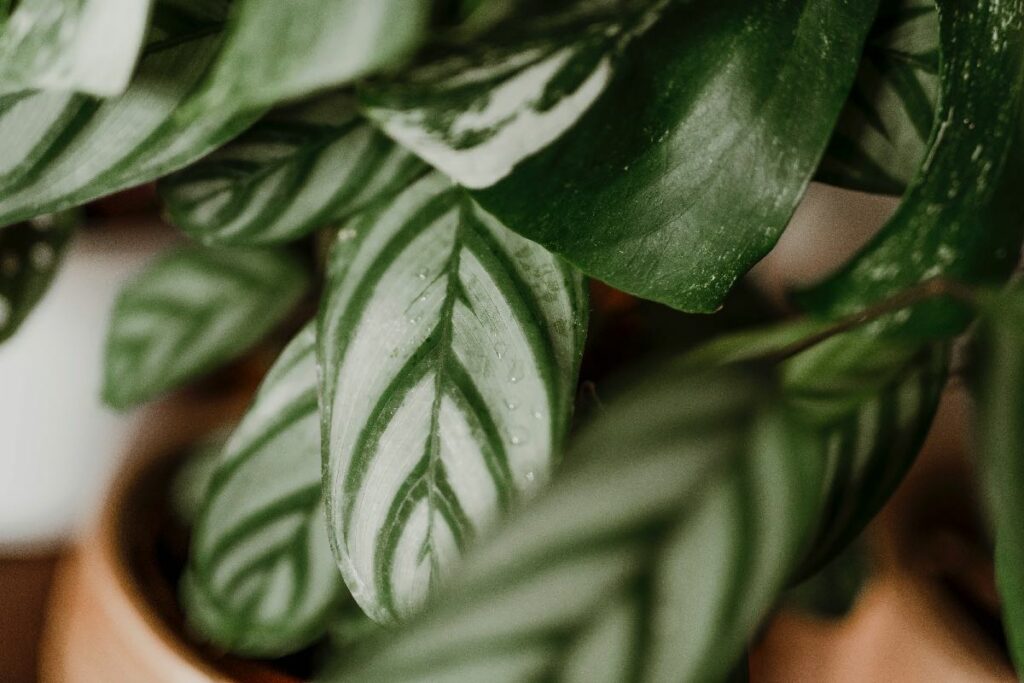Calathea plants are a fascinating and captivating choice for indoor plant enthusiasts, thanks to their intricate and striking foliage. These plants hail from the tropical regions of South America and boast a vibrant array of colors and patterns that are sure to catch the eye. Interestingly, Calathea plants are also known as prayer plants, due to their leaves’ unique ability to fold up at night, resembling hands in prayer.
With over 300 different species of Calathea plants, each with their own distinct characteristics and growing requirements, there is no shortage of variety when it comes to these plants. Some of the most popular types of Calathea plants include the Calathea orbifolia, Calathea medallion, and Calathea zebrina, each with their own unique and captivating features. From deep greens to bright pinks and purples, the leaves of these plants come in a wide range of colors and patterns that are sure to impress.
Beyond their aesthetic appeal, Calathea plants are also renowned for their air-purifying properties, making them an excellent choice for improving indoor air quality. While these plants are relatively easy to care for, they do require specific growing conditions to thrive. With the right care and attention, however, Calathea plants can make a stunning and distinctive addition to any indoor space.
What Makes Calathea Plants Unique?
Calathea plants are a true wonder of nature, boasting an array of unique and striking foliage that is sure to captivate any onlooker. With a vast range of colors and patterns, from deep greens to bright pinks and purples, these plants are a popular choice for those seeking to add a touch of exoticism to their indoor spaces.
But what truly sets calathea plants apart from other houseplants is their remarkable ability to move their leaves. This fascinating phenomenon, known as nyctinasty, sees the plant’s leaves fold up at night and then unfurl in the morning. This movement is believed to be a clever way for the plant to conserve moisture and protect itself from potential predators. These plants are able to remove harmful toxins from the air, ensuring that you and your loved ones can breathe easy.
All in all, calathea plants are a truly unique and captivating addition to any indoor space. With their striking foliage, ability to move their leaves, and air-purifying properties, it’s no wonder that they are a popular choice for plant enthusiasts and beginners alike.
Top 5 Best Types of Calathea Plants
Calathea plants are a sight to behold, with their stunning foliage and unique patterns. But with so many different types of calathea plants available, it can be quite the challenge to choose which one to add to your collection. That’s why we’ve compiled a list of the top 5 best types of calathea plants, each with its own distinct features and care requirements.
Calathea Orbifolia
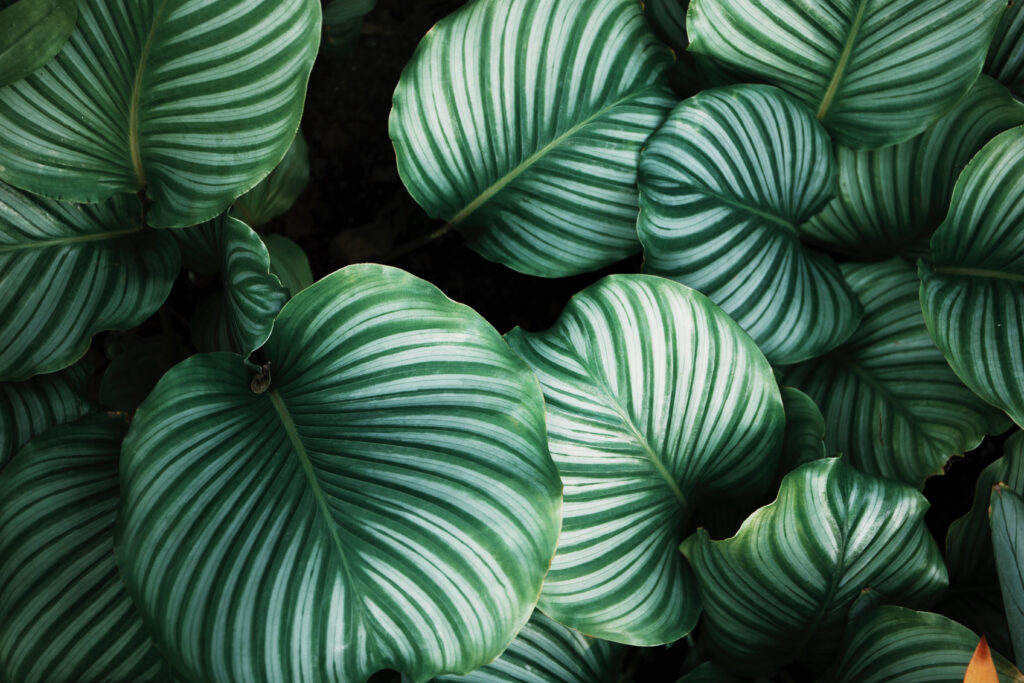
First up is the Calathea Orbifolia, a plant that boasts large, round leaves with silver stripes. This plant is a popular choice among plant enthusiasts due to its unique appearance and easy care requirements.
The Calathea Orbifolia is a plant that is truly a sight to behold. Its large, round leaves are adorned with intricate patterns of silver and green, making it a true work of art. This plant is native to Bolivia and is a popular choice for indoor gardening due to its unique appearance and low maintenance requirements.
One of the most striking features of the Calathea Orbifolia is its foliage. The leaves are large and round, with a diameter of up to 12 inches. The silver and green patterns on the leaves are highly detailed and intricate, making this plant a true work of art.
But the Calathea Orbifolia is not just a pretty face. It is also a low maintenance plant that is easy to care for. It prefers indirect light and moderate humidity, making it a great choice for indoor gardening. And it requires minimal watering, with only a weekly watering schedule needed to keep it healthy and thriving.
Overall, the Calathea Orbifolia is a beautiful and easy-to-care-for plant that is sure to add a touch of elegance to any indoor space. Its unique appearance and low maintenance requirements make it a popular choice for both novice and experienced gardeners alike. So why not add a touch of sophistication to your home with this stunning plant?
Calathea Medallion
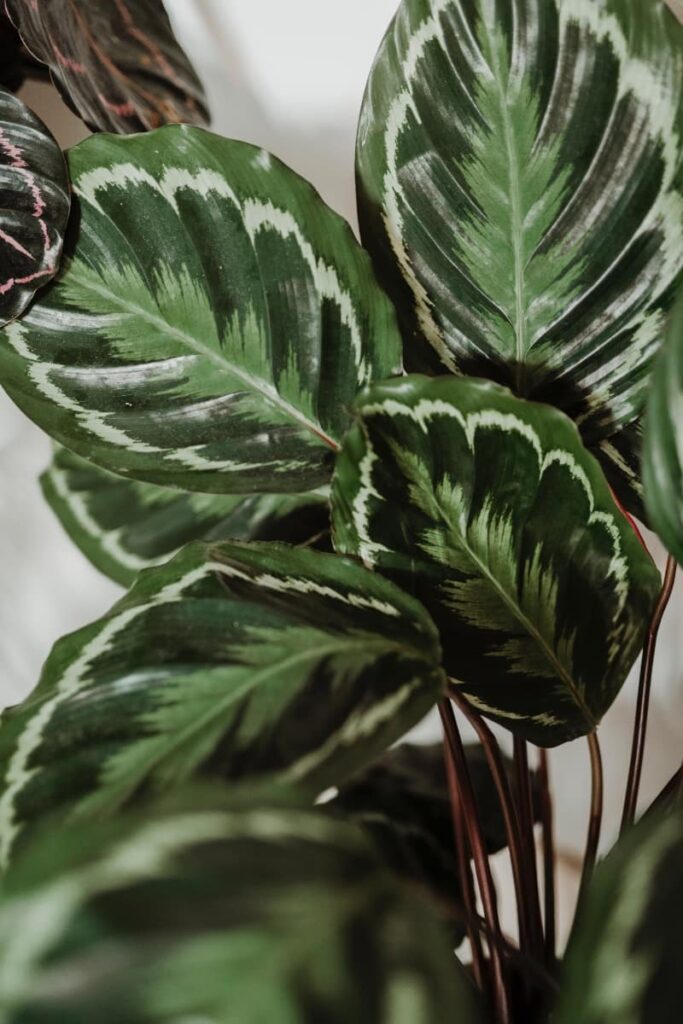
Next on the list is the Calathea Medallion, a stunning plant with dark green leaves and a prominent white pattern in the center. It’s a great choice for those who want a plant that’s both beautiful and easy to care for.
The Calathea Medallion is renowned for its stunning foliage. The plant boasts large, circular leaves that are a deep shade of green, with a striking silver pattern in the center that is sure to catch the eye. The underside of the leaves is a rich, regal purple, adding to the plant’s visual appeal and making it a popular choice among plant enthusiasts.
One of the most impressive features of the Calathea Medallion is its ability to thrive in low-light conditions. This makes it an excellent option for indoor spaces that don’t receive much natural light. Furthermore, this plant is relatively easy to care for, making it an ideal choice for beginners.
To ensure that your Calathea Medallion remains healthy, it is crucial to keep the soil moist but not waterlogged. The plant prefers well-draining soil and should be watered only when the top inch of soil feels dry to the touch. It is also important to avoid exposing the plant to direct sunlight, as this can cause the leaves to burn.
Overall, the Calathea Medallion is a stunning and low-maintenance plant that is perfect for adding a touch of greenery to any indoor space. Its unique foliage and ability to thrive in low-light conditions make it a top choice for plant enthusiasts everywhere.
Calathea Zebrina “Zebra Plant”
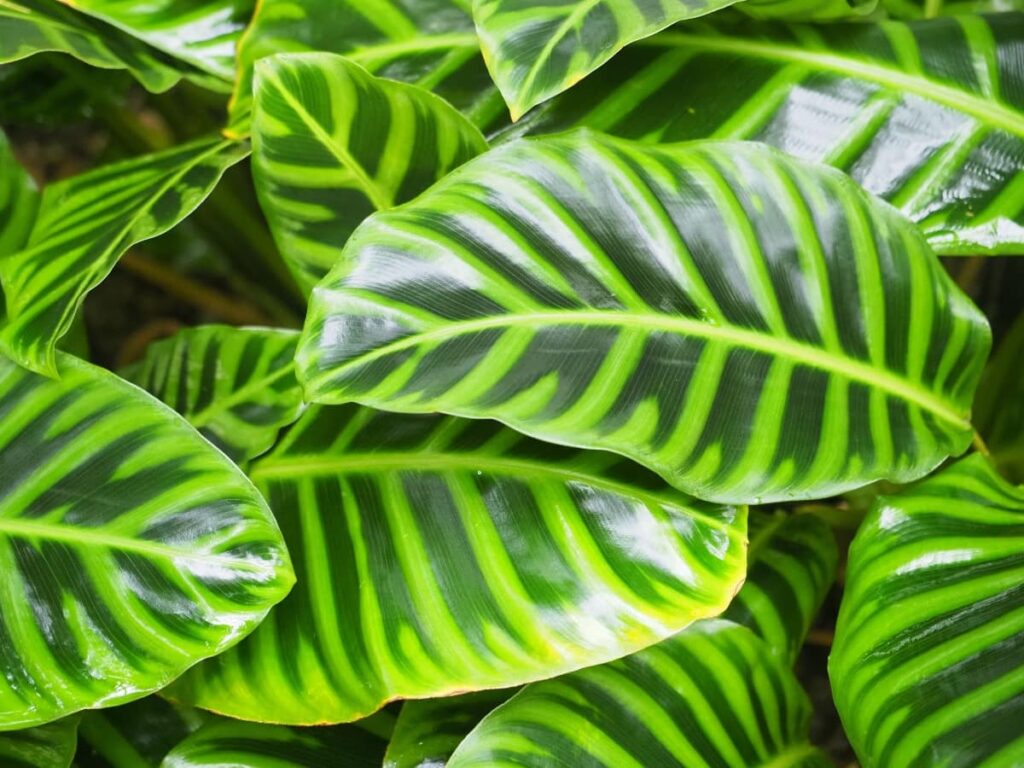
The Calathea Zebrina is a striking plant with deep green leaves and bold, zebra-like stripes. It’s a great choice for those who want a plant that’s both eye-catching and low-maintenance.
The Calathea Zebrina, better known as the Zebra plant, is a plant that is highly sought after by plant enthusiasts due to its striking appearance. The plant boasts long, slender leaves that are adorned with bold, white stripes that are reminiscent of the stripes of a zebra. The underside of the leaves is a deep purple color, which adds to its unique look and makes it stand out from other plants.
One of the benefits of owning a Calathea Zebrina is that it is relatively easy to care for. The plant prefers bright, indirect light and well-draining soil. It is important to keep the soil consistently moist, but not waterlogged, as this can lead to root rot. Additionally, the plant benefits from regular misting to increase humidity levels, which is essential for its growth and development.
Apart from its aesthetic appeal, the Calathea Zebrina is also known for its air-purifying properties. The plant can help to remove toxins such as formaldehyde and benzene from the air, making it a great addition to any home or office. This makes it a popular choice for those who are looking for a plant that not only looks great but also has health benefits.
Overall, the Calathea Zebrina is a beautiful and low-maintenance plant that can add a touch of exotic flair to any space. Its unique appearance and air-purifying properties make it a top choice for plant enthusiasts who are looking for a plant that is both aesthetically pleasing and beneficial for their health.
Calathea Lancifolia “Rattlesnake Plant”
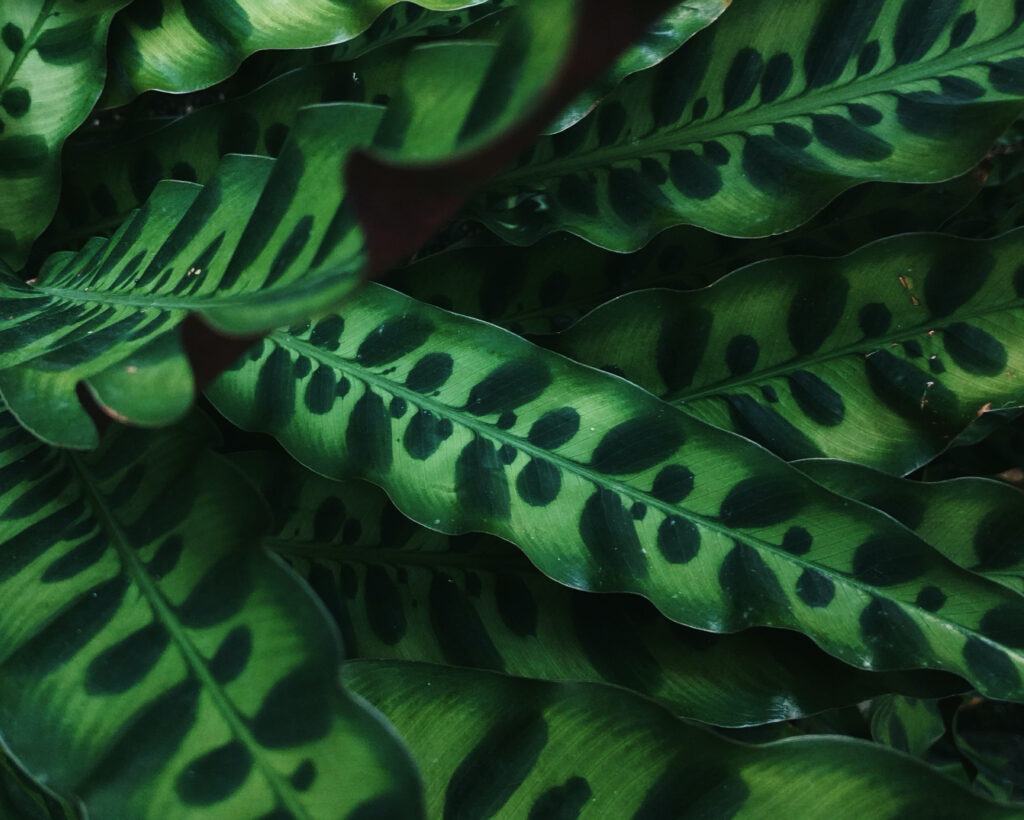
The Calathea Lancifolia, also known as the Rattlesnake plant, has long, narrow leaves with a unique pattern resembling the skin of a snake. It’s a great choice for those who want a plant that’s both unique and easy to care for.
The Calathea Lancifolia, also known as the Rattlesnake Plant, is a plant that is highly sought after by plant enthusiasts due to its striking and unique appearance. The plant boasts long, narrow leaves that are adorned with dark green stripes and a deep purple underside, giving it a distinctive and eye-catching rattlesnake-like appearance.
One of the most appealing aspects of the Calathea Lancifolia is that it is relatively easy to care for. It thrives in bright, indirect light and requires well-draining soil that should be watered regularly to keep the soil moist but not waterlogged. Additionally, the plant benefits from occasional misting to increase humidity levels.
Not only is the Calathea Lancifolia visually appealing, but it also has air-purifying properties that make it an excellent addition to any home or office space. The plant is known to remove harmful toxins from the air, such as formaldehyde and benzene, which can be found in common household items like cleaning products and furniture.
Overall, the Calathea Lancifolia is a low-maintenance plant that can add a touch of exotic elegance to any space. Its unique appearance and air-purifying properties make it a top choice for both plant enthusiasts and beginners alike.
Pinstripe Calathea
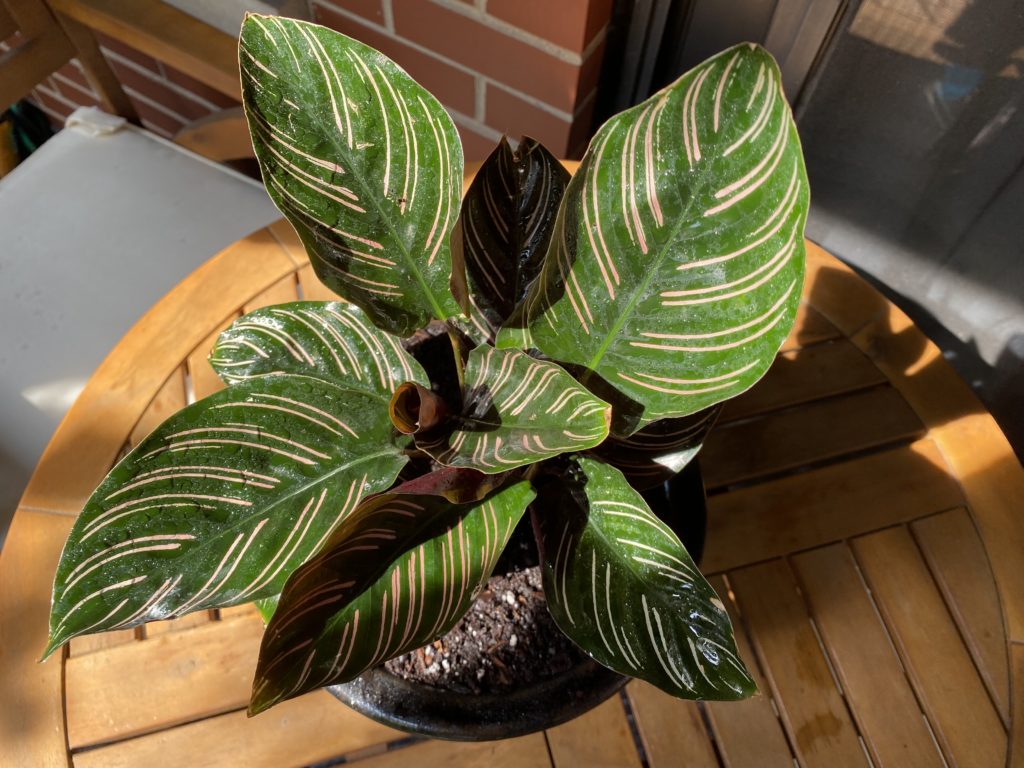
Last but not least is the Pinstripe Calathea plant. This plant has green leaves so dark they appear black at first glance. Pink stripes adorn these leaves, creating a string contrast that makes them look out of this world. Like other Calathea plants on this list, the Pinstripe Calathea loves high humidity, and may start to curl its leaves in drier environments. For those up to the challenge of keeping this stunning Calathea, the plant will reward you with large dark foliage that’s sure to start a conversation with guests visiting your home.
One of the most appealing aspects of the Pinstripe Calathea is its relatively easy care requirements. It thrives in bright, indirect light and well-draining soil, making it a great choice for those who want a low-maintenance plant. Additionally, this plant loves humid environments, making it an ideal choice for bathrooms or kitchens.
Another great feature of this Calathea is that it is non-toxic, making it safe for pets and children. Furthermore, this plant is known for its air-purifying properties, making it a fantastic addition to any home or office.
Overall, the Calathea Roseopicta is a stunning and low-maintenance plant that is perfect for anyone looking to add some color and texture to their indoor space. Its unique foliage and easy care make it one of the best types of Calathea plants available, and it is sure to be a conversation starter in any room.
These top 5 best types of calathea plants are sure to add a touch of beauty to any space. But remember, each one has its own unique characteristics and care requirements, so be sure to choose the one that best fits your needs and preferences.
How to Care for Calathea Plants
Calathea plants are a sight to behold with their stunning foliage and unique patterns, making them a popular choice for indoor plant enthusiasts. However, caring for these plants can be a bit tricky, as they require specific conditions to thrive. Fear not, for we have some tips on how to care for your calathea plants that will leave you feeling like a pro!
Calathea Water Needs
First, let’s talk about watering. Calathea plants prefer moist soil, but they don’t like to sit in standing water. It’s a delicate balance, but you can achieve it by watering your plant when the top inch of soil feels dry to the touch. Don’t forget to drain any excess water from the saucer, as standing water can lead to root rot.
Calathea Humidity Needs
Next up, humidity. Calathea plants are native to tropical regions and require high humidity to thrive. This can be achieved by placing a humidifier near your plant or by placing a tray of water near the plant and misting the leaves regularly. It’s like a spa day for your plant!
Calathea Lighting Needs
Now, let’s talk about light. Calathea plants prefer bright, indirect light. Direct sunlight can scorch their leaves, so it’s best to place them near a window with filtered light. Think of it like a beach vacation – they want to feel the warmth of the sun without getting burned.
Calathea Temperature Range
Temperature is also important. Calathea plants prefer temperatures between 65-80°F (18-27°C). Avoid placing them near drafty windows or air conditioning vents, as they prefer a cozy environment.
Calathea Soil Requirements
When it comes to soil, calathea plants prefer well-draining soil that is rich in organic matter. You can use a mix of peat moss, perlite, and vermiculite to create a suitable soil mix. It’s like a gourmet meal for your plant! Calathea plants don’t require frequent fertilization, but you can feed them once a month during the growing season with a balanced fertilizer. It’s like a vitamin boost for your plant!
By following these care tips, you can ensure that your calathea plants thrive and continue to add beauty to your indoor space. It’s like having a work of art in your home that you can nurture and watch grow. Happy planting!
Tips for Growing Calathea Plants Successfully
Calathea plants are a popular choice for indoor plant enthusiasts due to their stunning foliage and unique patterns. However, they can be quite finicky when it comes to care. Fear not, for we have compiled a list of tips to help you grow calathea plants successfully!
First and foremost, it is crucial to provide the right lighting for your calathea plant. These plants prefer bright, indirect light, as direct sunlight can scorch their leaves. On the other hand, too little light can cause their colors to fade. To strike the perfect balance, place your calathea plant near a window with filtered light or use a sheer curtain to diffuse the light.
Next up, keeping the soil moist is key. Calathea plants like to be kept consistently moist, but not waterlogged. It is recommended to water your plant when the top inch of soil feels dry to the touch. However, be sure to use room temperature water and avoid letting the plant sit in standing water.
The Importance of Humidity for Calathea Plants
Maintaining high humidity is also crucial for the success of your calathea plant. These plants are native to tropical regions and thrive in high humidity. You can increase humidity by placing a tray of water near the plant or using a humidifier. Misting the leaves can also help, but be careful not to get water on the foliage as it can cause damage.
Another important tip is to avoid cold drafts. Calathea plants are sensitive to temperature changes and do not like cold drafts. Therefore, it is best to keep your plant away from doors, windows, and air conditioning vents.
Last but not least, fertilizing your calathea plant regularly during the growing season (spring and summer) can promote healthy growth. It is recommended to use a balanced, water-soluble fertilizer every 2-3 weeks.
By following these tips, you can help your calathea plant thrive and enjoy its beautiful foliage for years to come.
Common Problems with Calathea Plants and How to Solve Them
Calathea plants are renowned for their stunning foliage and unique patterns, but they can be quite finicky when it comes to care. Here are some common issues you may encounter with your calathea plant and how to solve them:
First, brown or crispy leaf edges are a common problem with calathea plants, and it’s usually caused by low humidity levels. To solve this issue, you can try misting your plant regularly or placing a humidifier nearby. Alternatively, you can place a tray of water near your plant to increase humidity levels.
Second, yellowing leaves can be a sign of overwatering. Ensure that you’re allowing the soil to dry out slightly between waterings and that your pot has proper drainage. If the soil is consistently wet, your plant may be suffering from root rot.
Third, curling leaves can be a sign of both overwatering and underwatering. Check the soil moisture level and adjust your watering schedule accordingly. Curling leaves can also be a sign of low humidity levels, so try increasing the humidity around your plant.
Last, calathea plants are susceptible to pest infestations such as spider mites and mealybugs. If you notice small webs or white cottony spots on your plant, it may be a sign of an infestation. To solve this problem, try wiping down your plant with a damp cloth or using an insecticidal soap.
By addressing these common problems, you can help your calathea plant thrive and continue to show off its beautiful foliage.
Conclusion: Which Calathea Plant is Right for You?
The task of selecting the ideal Calathea plant for your home or office can be quite intimidating. However, fret not, as there are numerous types of Calathea plants available in the market. It is imperative to take into account your specific needs and preferences before making a decision.
If you are seeking a plant that requires minimal maintenance and can flourish in low-light conditions, then the Calathea Orbifolia or Calathea Medallion may be the perfect fit for you. Conversely, if you are looking for a plant with striking and distinctive foliage, then the Calathea Zebrina or Calathea Lancifolia may be more to your liking.
Ultimately, the best Calathea plant for you will hinge on your individual preferences and the conditions of your home or office. By dedicating time to research and contemplate your options, you can discover the ideal Calathea plant that will add splendor and vitality to your space.
Frequently Asked Questions
What are the best types of calathea plants?
Calathea plants are known for their beautiful foliage and are a popular choice for indoor plants. Some of the best types of calathea plants include:
What are the care requirements for calathea plants?
Calathea plants require bright, indirect light and high humidity. They prefer well-draining soil and should be watered regularly, but not overwatered. It is also important to keep the soil moist but not waterlogged. Calathea plants should be fertilized every two weeks during the growing season.
Why do the leaves of my calathea plant curl up?
The leaves of a calathea plant may curl up if the plant is not receiving enough water or if the air is too dry. It is important to keep the soil moist and to mist the leaves regularly to increase humidity. Curling leaves may also be a sign of pests or disease, so it is important to inspect the plant for any signs of infestation or illness.
Can calathea plants be propagated?
Yes, calathea plants can be propagated through division. This involves separating the plant into smaller sections and replanting them in fresh soil. It is best to do this in the spring or summer when the plant is actively growing.
Are calathea plants toxic to pets?
Yes, calathea plants are toxic to pets if ingested. They contain compounds that can cause gastrointestinal upset, vomiting, and diarrhea. It is important to keep calathea plants out of reach of pets and to seek veterinary care if a pet ingests any part of the plant.

